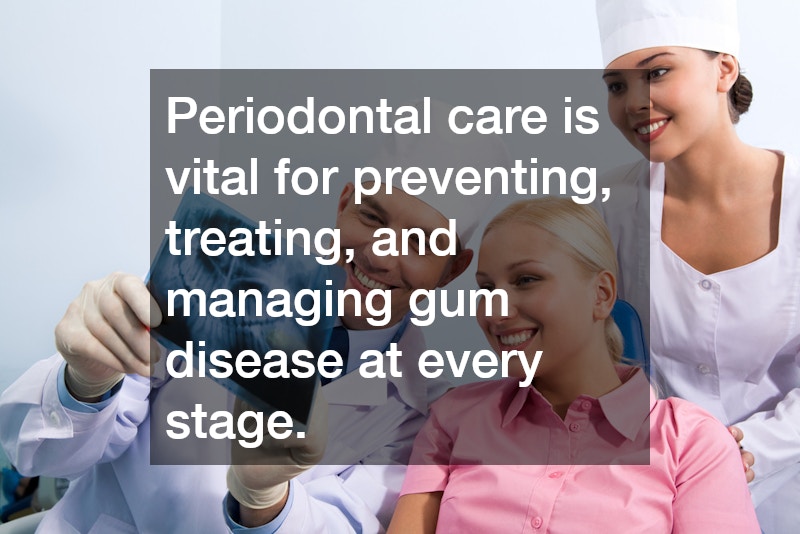Understanding Periodontal Care: How to Prevent and Treat Gum Disease
Periodontal care is essential to maintaining healthy gums and preventing gum disease, one of the most common yet overlooked oral health issues. Gum disease, also known as periodontal disease, affects the tissues that support and protect the teeth. Without proper care, it can lead to inflammation, infection, and even tooth loss.
By understanding the causes, prevention methods, and available treatments, patients can take proactive steps to preserve their oral health and overall well-being.
What Causes Gum Disease?
Bacterial Growth and Plaque Formation
Gum disease begins when bacteria in the mouth combine with food particles to form plaque—a sticky film that clings to the teeth and gums. If plaque is not removed through proper brushing and flossing, it hardens into tartar, which can only be removed by a dental professional. This buildup leads to gingivitis, the earliest stage of gum disease, characterized by redness, swelling, and bleeding. Without treatment, gingivitis can progress to periodontitis, a more severe form that damages the bone and connective tissue supporting the teeth.
Poor Oral Hygiene and Its Impact
Neglecting daily oral hygiene practices is one of the leading causes of gum disease. Irregular brushing and flossing allow bacteria to accumulate along the gumline, creating inflammation that can eventually destroy gum tissue. Consistent oral hygiene, including brushing twice daily and cleaning between the teeth, is critical to preventing bacterial buildup and maintaining healthy gums.
Risk Factors Beyond Oral Hygiene
While poor hygiene is a primary factor, several other conditions can increase the risk of developing gum disease. Genetics can make some individuals more susceptible to periodontal infections. Smoking significantly reduces the body’s ability to fight infection and heal gum tissue. Additionally, systemic health issues such as diabetes, heart disease, and certain medications can influence gum health. Understanding these risk factors allows patients and dental professionals to take preventive measures tailored to individual needs.
How Can Gum Disease Be Prevented?
Effective Daily Oral Care Routine
A thorough daily oral care routine is the cornerstone of periodontal care. Patients should brush their teeth twice a day with fluoride toothpaste and use dental floss or interdental brushes to clean between teeth. Incorporating an antibacterial mouthwash can also help reduce bacteria that cause plaque. Proper brushing technique, including gentle circular motions and attention to the gumline, ensures more effective cleaning and reduces irritation.
The Role of Regular Dental Check-Ups
Routine dental visits are vital for detecting early signs of gum disease and preventing progression. Professional cleanings remove hardened tartar that cannot be eliminated through brushing alone. During these visits, dentists and hygienists assess gum health, measure pocket depths, and provide personalized recommendations for maintaining oral hygiene. Regular checkups, typically every six months, allow for early intervention and help preserve gum and bone structure.
Healthy Lifestyle Choices
Lifestyle habits have a significant impact on gum health. A balanced diet rich in vitamins C and D, calcium, and antioxidants supports healthy gums and strong teeth. Avoiding tobacco use is equally important, as smoking restricts blood flow to gum tissue and hinders healing. Managing stress, staying hydrated, and limiting sugary foods can also contribute to better periodontal health and overall wellness.
What Are the Treatment Options for Gum Disease?
Non-Surgical Treatments
In its early stages, gum disease can often be managed with non-surgical treatments. Scaling and root planing, commonly known as deep cleaning, removes plaque and tartar from beneath the gumline and smooths the tooth roots to encourage reattachment of gum tissue. Dentists may also prescribe antimicrobial rinses or localized antibiotic treatments to control infection and promote healing.
Surgical Procedures
When gum disease advances beyond the reach of non-surgical care, more extensive treatments may be required. Flap surgery allows dentists to lift the gums and remove deep deposits of tartar while reshaping damaged bone if necessary. Bone grafts and soft tissue grafts help regenerate lost bone and strengthen areas affected by gum recession. These procedures aim to restore stability, prevent further deterioration, and preserve the natural teeth whenever possible.
Post-Treatment Care and Maintenance
After treatment, consistent follow-up care is crucial to prevent recurrence. Patients should maintain a strict oral hygiene routine and attend scheduled periodontal maintenance visits every three to four months. These visits allow the dental team to monitor healing and remove any new buildup. Adopting healthy habits, such as avoiding smoking and maintaining a nutritious diet, enhances long-term success and gum health.
Periodontal care is vital for preventing, treating, and managing gum disease at every stage. Understanding the causes of gum disease, practicing effective daily hygiene, and seeking professional dental care are key to preserving the health of your gums and teeth. With proactive attention and consistent care, you can protect your smile, prevent serious complications, and enjoy lasting oral health for years to come.

